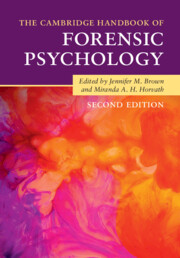Book contents
- The Cambridge Handbook of Forensic Psychology
- The Cambridge Handbook of Forensic Psychology
- Copyright page
- Dedication
- Contents
- Figures
- Tables
- Contributors
- Preface
- Forensic Psychology
- Part I Psychological Underpinnings
- Part II Psychology and Criminal Behaviour
- Part III Assessment
- Part IV Interventions
- 4.1 Forensic Mental Health Interventions
- 4.2 Restorative Justice
- 4.3 Treatment of Persons with Sexual Offense Histories
- 4.4 Strength-Based Approaches to Addiction Recovery and Desistance from Crime
- 4.5 Victimology and Victim Interventions
- 4.6 Interventions with Violent Offenders
- 4.7 Women Offenders
- 4.8 Preventing Delinquency and Later Criminal Offending
- Part V Civil Proceedings
- Part VI Professional Practices
- Index
- References
4.2 - Restorative Justice
Drawing from the Old to Develop New Justice Alternatives
from Part IV - Interventions
Published online by Cambridge University Press: 02 December 2021
- The Cambridge Handbook of Forensic Psychology
- The Cambridge Handbook of Forensic Psychology
- Copyright page
- Dedication
- Contents
- Figures
- Tables
- Contributors
- Preface
- Forensic Psychology
- Part I Psychological Underpinnings
- Part II Psychology and Criminal Behaviour
- Part III Assessment
- Part IV Interventions
- 4.1 Forensic Mental Health Interventions
- 4.2 Restorative Justice
- 4.3 Treatment of Persons with Sexual Offense Histories
- 4.4 Strength-Based Approaches to Addiction Recovery and Desistance from Crime
- 4.5 Victimology and Victim Interventions
- 4.6 Interventions with Violent Offenders
- 4.7 Women Offenders
- 4.8 Preventing Delinquency and Later Criminal Offending
- Part V Civil Proceedings
- Part VI Professional Practices
- Index
- References
Summary
Restorative justice is an approach that offers offenders, victims and the community an alternative pathway to justice instead of the formal adversarial process in common law court jurisdictions. Restorative justice focuses upon the safe participation of victims in resolving the aftermath of crime with the offender. The approach encourages people to accept responsibility for the harm caused by their actions and an opportunity to make themselves accountable to those they have harmed. Restorative approaches recognize the harm that criminal behaviour has upon both the victim and greater community. Restorative justice though entering the lexicon of modern criminology during the mid-1950’s has a much older provenance with it being present in many indigenous and ancient cultures throughout the world. Restorative justice offers therapeutic benefits to the victims of crime as well as benefits to those who have committed crime.
- Type
- Chapter
- Information
- The Cambridge Handbook of Forensic Psychology , pp. 514 - 529Publisher: Cambridge University PressPrint publication year: 2021



